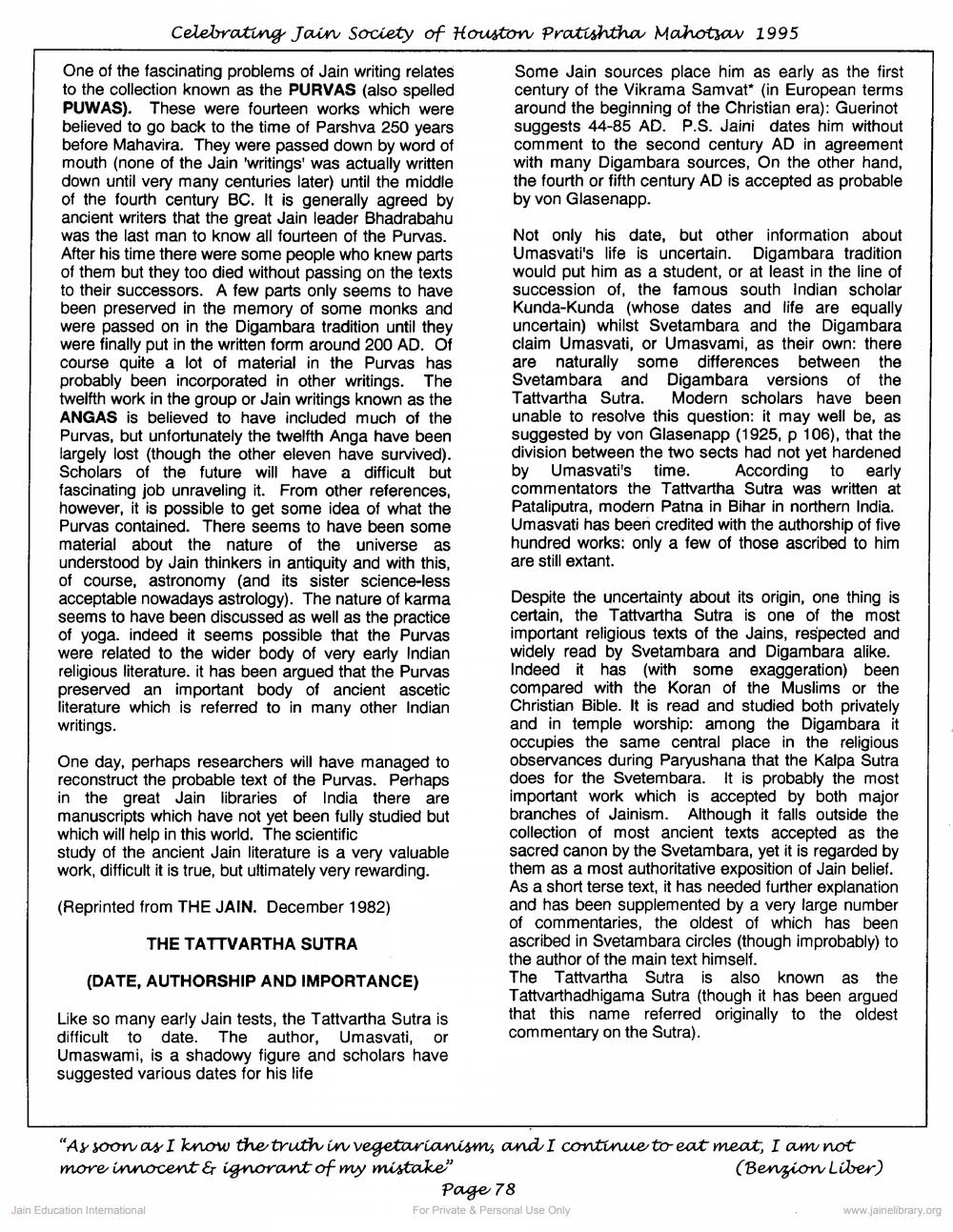________________
Celebrating Jain Society of Houston Pratishtha Mahotsav 1995
Some Jain sources place him as early as the first century of the Vikrama Samvat" (in European terms around the beginning of the Christian era): Guerinot suggests 44-85 AD. P.S. Jaini dates him without comment to the second century AD in agreement with many Digambara sources, On the other hand, the fourth or fifth century AD is accepted as probable by von Glasenapp.
One of the fascinating problems of Jain writing relates to the collection known as the PURVAS (also spelled PUWAS). These were fourteen works which were believed to go back to the time of Parshva 250 years before Mahavira. They were passed down by word of mouth (none of the Jain 'writings' was actually written down until very many centuries later) until the middle of the fourth century BC. It is generally agreed by ancient writers that the great Jain leader Bhadrabahu was the last man to know all fourteen of the Purvas. After his time there were some people who knew parts of them but they too died without passing on the texts to their successors. A few parts only seems to have been preserved in the memory of some monks and were passed on in the Digambara tradition until they were finally put in the written form around 200 AD. Of course quite a lot of material in the Purvas has probably been incorporated in other writings. The twelfth work in the group or Jain writings known as the ANGAS is believed to have included much of the Purvas, but unfortunately the twelfth Anga have been largely lost (though the other eleven have survived). Scholars of the future will have a difficult but fascinating job unraveling it. From other references, however, it is possible to get some idea of what the Purvas contained. There seems to have been some material about the nature of the universe as understood by Jain thinkers in antiquity and with this, of course, astronomy (and its sister science-less acceptable nowadays astrology). The nature of Karma seems to have been discussed as well as the practice of yoga. indeed it seems possible that the Purvas were related to the wider body of very early Indian religious literature. it has been argued that the Purvas preserved an important body of ancient ascetic literature which is referred to in many other Indian writings.
Not only his date, but other information about Umasvati's life is uncertain. Digambara tradition would put him as a student, or at least in the line of succession of, the famous South Indian scholar Kunda-Kunda (whose dates and life are equally uncertain) whilst Svetambara and the Digambara claim Umasvati, or Umasvami, as their own: there are naturally some differences between the Svetambara and Digambara versions of the Tattvartha Sutra. Modern scholars have been unable to resolve this question: it may well be, as suggested by von Glasenapp (1925, p 106), that the division between the two sects had not yet hardened by Umasvati's time. According to early commentators the Tattvartha Sutra was written at Pataliputra, modern Patna in Bihar in northern India. Umasvati has been credited with the authorship of five hundred works: only a few of those ascribed to him are still extant.
One day, perhaps researchers will have managed to reconstruct the probable text of the Purvas. Perhaps in the great Jain libraries of India there are manuscripts which have not yet been fully studied but which will help in this world. The scientific study of the ancient Jain literature is a very valuable work, difficult it is true, but ultimately very rewarding.
Despite the uncertainty about its origin, one thing is certain, the Tattvartha Sutra is one of the most important religious texts of the Jains, respected and widely read by Svetambara and Digambara alike. Indeed it has (with some exaggeration) been compared with the Koran of the Muslims or the Christian Bible. It is read and studied both privately and in temple worship: among the Digambara it occupies the same central place in the religious observances during Paryushana that the Kalpa Sutra does for the Svetembara. It is probably the most important work which is accepted by both major branches of Jainism. Although it falls outside the collection of most ancient texts accepted as the sacred canon by the Svetambara, yet it is regarded by them as a most authoritative exposition of Jain belief. As a short terse text, it has needed further explanation and has been supplemented by a very large number of commentaries, the oldest of which has been ascribed in Svetambara circles (though improbably) to the author of the main text himself. The Tattvartha Sutra is also known as the Tattvarthadhigama Sutra (though it has been argued that this name referred originally to the oldest commentary on the Sutra).
(Reprinted from THE JAIN. December 1982)
THE TATTVARTHA SUTRA
(DATE, AUTHORSHIP AND IMPORTANCE)
Like so many early Jain tests, the Tattvartha Sutra is difficult to date. The author, Umasvati, or Umaswami, is a shadowy figure and scholars have suggested various dates for his life
"As soon as I know the truth in vegetarianism, and I continue to eat meat, I am not more innocent & ignorant of my mistake"
(Benzion Liber)
Page 78 Jain Education Intemational For Private & Personal Use Only
www.jainelibrary.org




